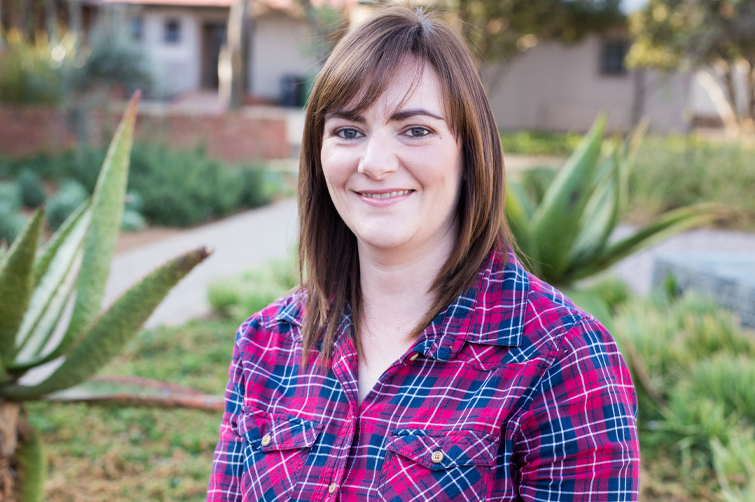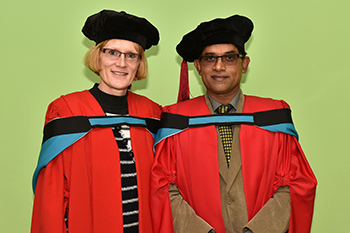Latest News Archive
Please select Category, Year, and then Month to display items
31 December 2019
|
Story Dr Cindé Greyling
|
Photo Anja Aucamp
 Dr Mariana Erasmus, SAENSE Platform Manager, says water remediation is vital for both the ecosystem and industries.
Dr Mariana Erasmus, SAENSE Platform Manager, says water remediation is vital for both the ecosystem and industries.
KovsieInnovation at the UFS supports innovative research outputs in various ways – one of which is to protect the intellectual property and to register patents where viable. This is in line with KovsieInnovation’s broader aim to create third-stream income for the university. Patent registration is a complex process and the UFS is proud to have the needed expertise to properly facilitate such an endeavour.
The SAENSE Platform
South Africa is a water-scarce country, with many water hungry industries (such as agriculture and mining). “Industrial processes often contaminate water with heavy metals, harmful chemicals, radioactive waste, and even organic sludge,” Dr Mariana Erasmus, SAENSE Platform Manager, explains.
Hence, water remediation is vital for both the ecosystem and industries. One of the key functions of the SAENSE Platform is to offer water-remedial solutions for the (bio)remediation of nitrates, heavy metals, and salts, among others. The platform’s activities and services are supported by undergraduate and postgraduate students and researchers, using Technology Innovation Agency (TIA) funding. TIA is a national public entity that serves as key institutional intervention to bridge the innovation chasm between research and development.
From waste to water
Through the joint effort of two mining companies and the UFS/TIA SAENSE Research Platform, a new treatment for mine drainage (MD) has been developed. This patented B-DAS (Barium – Dispersed Alkaline Substrate) technology effectively treats the major contaminants found in acid, alkaline, or neutral mining wastewater. The aim of the B-DAS system is to provide a passive water-treatment solution with minimum waste production; it can also be a potential pre-treatment for reverse osmosis (RO) to lower the requirements of the membranes and therefore potentially reduce the RO cost.
The success of the patent is that it turns unusable water into water that is fit for agricultural purposes at a reduced cost and increased efficiency.
Using sugar to make the world a sweeter place
2017-10-13

Dr Deepack Santchurn, former PhD student in the
Department of Plant Sciences at the UFS,
and plant breeder in the Mauritius Sugar Industry
Research Institute, with Prof Maryke Labuschagne, left,
Dr Santchurn’s study leader.
Photo: Charl Devenish
Besides it mainly being used for sugar production, sugarcane has emerged as an important alternative for providing clean renewable energy. Dr Deepack Santchurn, who works in the sugarcane breeding department of the Mauritius Sugar Industry Research Institute (MSIRI), believes if he could contribute towards a more environment-friendly and renewable energy through the use of sugarcane biomass, he would consider himself having made a great leap towards a better world.
Sugarcane is mostly known and exploited for the sugar in its cane stem. According to Dr Santchurn it is not the only thing the crop does well. “Together with certain grasses, it is the finest living collector of sunlight energy and a producer of biomass in unit time. Sugarcane is now recognised worldwide as a potential renewable and environment-friendly bioenergy crop.”
Significantly more bioenergy can be produced from sugarcane if the production system is not focused on the production and recovery of sucrose alone but on the maximum use to the total above-ground biomass. Diversification within the sugarcane industry is of paramount importance.
He has been able to identify a few high biomass varieties that can be exploited industrially. One of the varieties is a commercial type with relatively high sugar and low fibre in the cane stem. Dr Santchurn explains: “Its sucrose content is about 0.5% less than the most cultivated commercial variety in Mauritius. Nevertheless, its sugar yield and above-ground biomass yield surpass those of the commercial varieties by more than 24%. The genetic gains compared to commercial varieties were around +50% for total biomass yield and +100% for fibre yield. Its cultivation is strictly related to bio-energy production and the extracted juice can be used as a feed-stock for ethanol and other high-value products.”
Dr Santchurn received his PhD at the UFS’s Department of Plant Sciences during the Winter Graduation Ceremonies in June this year. His study leader was Prof Maryke Labuschagne from the Department of Plant Sciences.